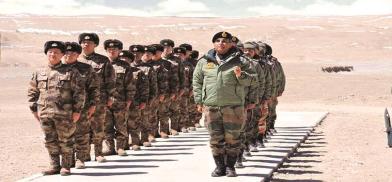Chinese disengagement in Ladakh is a small lollipop to India!
It is quite possible that the Indian side conveyed to Beijing that with China’s rigid stance on the border standoff, Prime Minister Narendra Modi may consider it difficult to attend the summit, and more importantly, a one-to-one meeting between PM Modi and Chinese President Xi Jinping may not be possible unless Beijing shows some progress on further disengagement

The 16th round of Corps Commander-level talks over the India-China standoff in Eastern Ladakh held on July 17, 2022, led by the Leh-based 14 Corps Commander, Lieutenant General Anindya Sengupta, and China's South Xinjiang Military District Commander, Major General Yang Yin, had indicated no breakthrough.
During the 15th round of talks, held on March 11, 2022, that lasted for around 13 hours, the Indian side had pushed China for the resolution of remaining intrusion areas (dubbed "friction points") in Ladakh but there was also no breakthrough. India had hoped that a resolution on Patrolling Point (PP) 15 in Hot Springs would be arrived at but the joint statement issued after the talks said that the "two sides carried forward their discussions from the previous round", 14th round, held on January 12, "for the resolution of relevant issues along the LAC in the Western Sector". It said both sides "agreed to maintain dialogue via military and diplomatic channels to reach a mutually acceptable resolution at the earliest".
Not only was the 14th round of talks inconclusive, but the 13th Corps Commander-Level meeting that took place on October 21, 2021, also ended in a stalemate, after which the Indian Army said that the "constructive suggestions" it made were not agreeable to the Chinese side, which also could not provide any "forward-looking" proposals. The Chinese later released a press statement calling India's demands "unreasonable".
Now almost two months after the 16th round of Corps Commander-level talks, India's Ministry of External Affairs (MEA) has issued a statement on September 8, 2022, that reads: “On 08 September 2022, according to the consensus reached in the 16th round of India China Corps Commander Level Meeting, the Indian and Chinese troops in the area of Gogra-Hotsprings (PP-15) have begun to disengage in a coordinated and planned way, which is conducive to the peace and tranquillity in the border areas.”
Sudden disengagement
The next day on September 9, China’s state media Global Times tweeted: “Chinese and Indian troops in the area of Jianan Daban have begun to disengage in a coordinated and planned manner on Thursday (September 8), according to the consensus reached on 16th Round of China-India Corps Commander Level Meeting: Chinese Defense Ministry.”
It is significant to note that the 16th round of talks was held ten days after India's External Affairs Minister S Jaishankar had an hour-long meeting with Chinese Foreign Minister Wang Yi in Bali, Indonesia, on July 7, 2022, on the sidelines of a meeting of the foreign ministers of the G20 countries. After the discussion, Jaishankar stated that he had focused on specific outstanding issues in India-China bilateral relationship pertaining to the border situation. But despite this, China gave no indication of any possibility of changing the status quo in Eastern Ladakh.
How then is this sudden disengagement at PP 15? The 2022 annual summit of the Shanghai Cooperation Organization (SCO) Heads of State is being held on September 15-16 at Samarkand, Uzbekistan, Uzbekistan has taken over the chairmanship of SCO from Tajikistan in September last year. It is quite possible that the Indian side conveyed to Beijing that with China’s rigid stance on the border standoff, Prime Minister Narendra Modi may consider it difficult to attend the summit, and more importantly, a one-to-one meeting between PM Modi and Chinese President Xi Jinping may not be possible unless Beijing shows some progress on further disengagement.
As per recent news, the Chinese side has pulled back northeast of PP 17A while the Indian troops have pulled back to PP-17. In between is the no-patrol zone which means that Indian troops can no more patrol up to PP 15 which was our forward PP in this sector.
China loses nothing
On the other hand, China loses nothing. The extent of the buffer zone has not been specified. China has ensured the buffer zone since PP-15 in the Kungrang Nullah area provides an access route to Kongka La - a key pass leading into the Aksai Chin hinterland and beyond. In the event of any possibility of hostilities, China can reoccupy PP 15 at the earliest.
The deepest intrusion by China is at Y Junction in the Depsang area – 20 km deep. This denies our patrols to go up to PPs 10, 11, 11A, 12 and 13, even as these PPS were cited short of the Line of Actual Control (LAC). Moreover, India vacated the Kailash Range without linking it with the Chinese withdrawal from Depsang and Demchok areas.
Having consolidated its defences in the intrusion areas, China is sitting pretty in Eastern Ladakh with buffer zones in Indian territory, continuing to block traditional patrolling areas in Depsang plains and Charding Nala regions, and denying traditional grazing areas to our villagers in Eastern Ladakh.
Disengagement from PP 15 is just a small lollipop to India.
(The author is an Indian Army veteran. Views are personal.)









Post a Comment